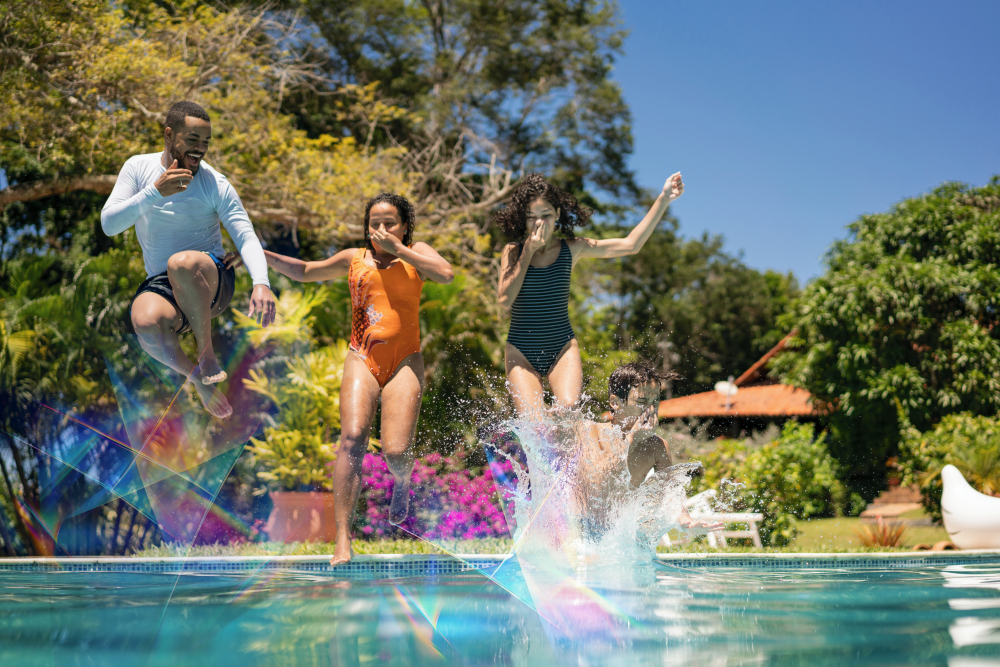Chlorine in pool water is measured in three forms: free, combined, and total chlorine. Understanding the chemistry behind each measurement is essential for maintaining the ideal sanitizing balance. Staying on top of these values requires knowing exactly what each form represents, how levels fluctuate, and which testing tools can give the most reliable readings.
Free Chlorine
Free chlorine, or FC, is the available sanitizer that is ready to combat bacteria and other impurities. A minimum of 1 part per million is recommended in a pool with an elevated target of 2 ppm or more whenever cyanuric acid (CYA), a stabilizer that shields chlorine from the sun, is added to the water. Maintaining your free chlorine levels between 2–4 ppm throughout the swimming season is recommended. Cloudy water, green walls, and a musty odor can occur when free chlorine levels drop below the recommended threshold.
Taylor's K‑1001 Three‑Way Test Kit includes a convenient drop-and-swirl method that can be completed in under a minute.
Combined Chlorine
After chlorine reacts with sweat, sunscreen, and other organic substances, it becomes combined chlorine (also known as chloramines). At this point, the sanitizer has done its job, but the by-products of combined chlorine can cause eye irritation and create that familiar "pool smell." In reality, the smell means that the pool needs a supplementary dose of chlorine, in the form of a shock treatment, to break down the chloramines and make the sanitizer effective again.
Ideally, the combined chlorine level should be less than four-tenths of a part per million. If it is higher than that, shocking the water may be necessary to re-balance the water quality level. Taylor's K-1004 Six-Way Test Kit gives you a direct read of combined chlorine and has stabilizer testing, making it a staple for complete weekly testing. Testing once or twice weekly, particularly after heavy swimmer loads or thunderstorms, allows you to take action ahead of any noticeable changes.
Total Chlorine
Total chlorine is the sum of free and combined chlorine. It provides an overview of the overall chlorine reserve that allows you to calculate the amount of combined chlorine if needed. When free chlorine and total chlorine are equal, it is an indication that combined chlorine is near zero, showing that the water is properly sanitized. However, if total chlorine exceeds 0.4 ppm over free chlorine, it's time to plan for a shock treatment.
For the fastest overall chlorine reading, dip a Taylor S‑1403 7‑Way Test Strip, wait for 20 seconds, and match the color blocks.
Why Test All Three?
Each chlorine reading addresses a specific maintenance issue, and together, they form a composite picture of water health. Free chlorine informs you if there is an active sanitizer present and working. Combined chlorine alerts you that chloramines have accumulated, and you must evaluate them to take further action. Measuring total chlorine helps determine your chlorine's effectiveness and protect against potential reading errors. Checking free chlorine daily during peak season prevents surprises, while including combined and total chlorine into your weekly routine catches issues early.
Everyday Testing Tips
Collect your water sample elbow-deep beneath the surface, making sure you position yourself away from return jets.
Run tests at roughly the same time daily. Morning is ideal because sunlight hasn't begun to break down the chlorine in the water. Store your reagents and test strips away from heat, cold, and direct sunlight. When storing, ensure lids are screwed on tightly and kept in an airtight container. Recording results in a notebook or the Taylor app will also bring slow changes to your attention that might otherwise be missed.
Understanding the different functions of free, combined, and total chlorine helps make pool maintenance a simple, manageable routine. With Taylor Test Kits and Test Strips, you can act on shifting conditions while protecting your pool surfaces and equipment. That way, your water is always healthy, welcoming and swim-ready!
Are you ready to put an end to pool maintenance guesswork? Explore the complete line of Taylor Test Kits and Taylor Test Strips today.

